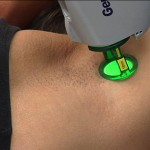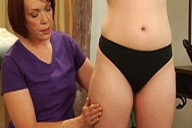Hyping Up Hair Removal
0Body hair is a prevalent issue for the spa-going public, and its removal translates into one of the most lucrative services available. Practicing under the “if it isn’t broken, don’t fix it” concept, hair removal methods basically have remained the same for some time, with the most popular ones usually being waxing, electrolysis and laser hair removal.
This isn’t breaking news—in fact, most spas offer at least one of these techniques due to their high demand and amazing return-on-investment.
Because of the increasing popularity and presence of these techniques, you must identify ways to distinguish your business and its hair removal treatments from the spa’s down the street. Bottom line: The extras make all the difference. From cooling devices to ceiling-hung TVs, spas are making hair removal a better encounter every day.
Waxing
Waxing is a temporary hair removal method that involves pulling hair out from the root, resulting in hairless areas for three to eight weeks. Most of the body can be waxed, including the back, bikini area, legs and eyebrows.
Comfort amenities can be provided to waxing clients in order to transform what many view as an uncomfortable-yet-necessary experience into an almost enjoyable one.
Comfort amenities. From pain-relieving creams to waxes featuring aromatherapeutic benefits, the waxing experience is becoming more pleasant. Over-the-counter and professional topical numbing creams and sprays are available containing lidocaine and benzocaine, which help take the sting out of waxing if applied 15–20 minutes before the service.
Many waxes are beginning to include specific ingredients to address skin issues, as well. For example, soy is becoming more popular in wax formulas due to its anti-inflammatory and moisturizing properties. Waxes also are available in an ever-increasing variety of fragrances—from floral to fruity—fostering aromatherapeutic benefits based on the power of scent.
Also, consider the environment in which your waxing services are provided. Is it utilitarian, or is it a room that creates an experience? “Make hair removal a ‘treatment,’ not a simple, quick, uncomfortable experience that a person has to do,” encourages Michelle D’Allaird, CIDESCO diplomate and owner of the Aesthetic Science Institute in Latham, New York. Consider referencing feng shui and incorporating elements into the room that inspire a sense of peace—running water, fireplaces, a stone path, calming music. Another route is the more modern, more utilitarian one that New York’s Completely Bare subscribes to: TV. Ceiling-hung televisions provide a great distraction for hair removal clients.
Electrolysis and laser hair removal
Electrolysis is electrical epilation for the purpose of permanently removing hair. In this method, an electrologist places an extremely thin metal probe into a hair follicle to deliver electricity that damages the hair-generating areas, either through the galvanic method, which forms caustic lye, or the thermolysis method, which utilizes overheating. These two methods also can be administered separately or blended.
The most recent introduction into the hair removal market is laser hair removal. Its popularity continues to grow with the increase of medical spas around the country. In fact, the American Society for Aesthetic Plastic Surgery (ASAPS) recently identified laser hair removal as the third most popular noninvasive cosmetic procedure for women and the second most popular one for men in 2006.
The method provides permanent hair removal and, because a large area can be treated at once, it can be cost-effective. A low-energy beam is absorbed by melanin present in the hair follicle shaft. Because hair cycles as it grows, repeated treatments must occur in order to destroy approximately 80% of hair. Ruby, alexandrite and diode were the first lasers approved for hair reduction, and intense pulsed light (IPL) systems also are used, though mainly on light-skinned, dark-haired individuals. According to the American Academy of Dermatology (AAD), this is because dark pigments in the skin cannot absorb the light they emit. Lasers with longer wavelengths, such as the Nd:YAG laser, can treat darker skin types.
Specific relief for clients who endure permanent hair removal methods comes in the form of cooling devices and time-savers.
This article was originally published in the June 2007 issue of Skin Inc. Magazine and is being reprinted with permission. All rights reserved.





